
Smartphone cameras have come a long way in the past decade. What started as just a handy tool to snap quick pics has now transformed into a powerful tech feature that can rival even professional cameras. If you’ve been browsing for a new smartphone in Malaysia recently, chances are you’ve seen plenty of buzzwords thrown around — megapixels, AI cameras, night mode, and more. But what do these terms really mean? And how do they impact the photos you take, whether you’re capturing a nasi lemak feast or the vibrant streets of KL?
In this article, we’ll break down all the jargon in a simple way and explain how these camera features work to help you snap better photos. So, whether you’re a casual Instagrammer or someone who wants to take beautiful memories in high quality, this guide is for you!

Editor
Mae An NG chevron_right
Table of Contents
What are Megapixels

In Malaysia, it’s common to hear people say, “Aiyo, this phone got 108MP camera leh, must be very good one!” or “My friend’s phone got 200MP, confirm better than mine.” This hype comes from years of marketing focusing on megapixels as the ultimate measure of camera quality.
Smartphones have evolved dramatically, and brands compete fiercely on specs. The latest Samsung Galaxy S25 Ultra boasts an incredible 200MP camera — that’s double the megapixels of last year’s models! Meanwhile, Xiaomi’s Mi 14 Pro comes with a 108MP shooter that promises jaw-dropping clarity. At a glance, these numbers are mind-blowing and look perfect for those who love snapping photos of everything, from nasi lemak at mamak stalls to breathtaking shots of Langkawi’s beaches.
But, here’s the catch: megapixels alone don’t guarantee the best photos.
Why Megapixels Aren’t Everything
Imagine you’re looking at a delicious plate of your favorite grub. The number of pixels (megapixels) is like how many tiny dots are in the picture of that dish, more dots might mean you can see more details, like the charred bits or the prawns. But if the camera’s software can’t process the picture well, or if the sensor is too small, the photo might still come out blurry or dull, no matter how many megapixels it has.
Here are some other key factors that affect photo quality:
Sensor Size Matters
Bigger sensors capture more light, essential for Malaysia’s often tricky lighting conditions, like shooting indoors or during the rainy season. More light means clearer and less noisy photos. So, a phone with a 50MP camera but a big sensor might outperform a 108MP camera with a tiny sensor.
Image Processing Power
After the camera captures the image, your phone’s software kicks in to improve it. This includes adjusting colors, sharpening details, and reducing noise. Brands like Samsung and Xiaomi have invested heavily in AI-based image processing, so even lower-megapixel cameras can produce stunning photos.
Lens Quality and Aperture
A great camera isn’t just about megapixels; it’s also about the lens that captures the light. Phones with wide apertures (like f/1.8 or lower) let in more light, which helps especially in Malaysia’s lower-light scenes—think candlelight dinners or bustling night markets.
Additional Features
Features like optical image stabilization (OIS), night mode, and advanced zoom technology make a big difference. For instance, the Samsung Galaxy S25 Ultra’s 10x optical zoom allows you to capture sharp images of distant objects, perfect for taking photos of the Petronas Twin Towers from afar.
What About Video?
If you love sharing your life on social media — from Instagram Reels to TikTok videos, camera quality is just as important for video as it is for photos.
- Phones with higher megapixels can record sharper video, but stabilization and software enhancements are crucial for smooth footage.
- The Galaxy S25 Ultra supports 8K video recording, but if you’re mostly uploading to social media, 4K with good stabilization is more than enough.
- Features like Super Slow-Mo and AI video enhancements are great for creative shots that stand out online.
What Exactly is an AI Camera

Imagine having a personal photographer inside your phone, one who knows exactly how to make your pictures pop without you having to fiddle with complicated settings. That’s what AI (Artificial Intelligence) cameras bring to the table. Instead of you adjusting ISO, exposure, or white balance manually like in traditional photography, AI uses smart algorithms to do all that for you, automatically.
AI cameras analyze every frame in real-time, detecting scenes, lighting conditions, and even subjects. This lets your phone optimize the photo instantly, making colors more vibrant, details sharper, and skin tones more natural. No more guesswork or spending hours editing photos before sharing on Instagram or TikTok!
How AI Camera Works
One of the best examples of AI camera tech is found in the latest iPhone 15 Pro Max, which uses AI to recognize over 20 different types of scenes: landscapes, food, pets, portraits, and more. When you point your phone at any of these scenes, the AI immediately tweaks settings like exposure, white balance, and contrast to match the scene perfectly.
This tech also helps in tricky conditions like low light. Ever tried snapping a photo in a dimly lit cafe or during a night walk? Traditional cameras often produce grainy, noisy photos in such settings. The AI in the iPhone 15 Pro Max reduces this noise, brightens the scene, and retains details that would otherwise be lost, all without you needing to pull out a flashlight or tripod.
Bringing Professional Photography to Your Fingertips
If you’re wondering whether AI cameras can replace a real photographer, the answer is—they’re getting close! Features like night mode, portrait mode with advanced bokeh, and real-time skin tone enhancement are designed to simulate professional techniques.
For selfies, AI cameras don’t just take a basic shot; they detect facial features, smooth skin tones naturally (no plastic-looking filters here), and even adjust lighting to make you look your best. Whether you’re snapping a quick selfie before heading out or capturing your friends’ reactions at a wedding, AI makes sure you shine in every frame.
What’s Next for AI in Smartphone Cameras?
The AI camera revolution is just getting started. We’re already seeing phones use AI not just for photos, but for video enhancements too—stabilizing shaky footage, improving dynamic range, and even suggesting the best shots during video recording.
Future AI developments may include better real-time translation of signboards when you travel across Malaysia, instant recognition and tagging of objects in your photos, or even AR features that let you experiment with different backgrounds or lighting on the fly.
Megapixels vs. AI Camera
What really matters for your photos? When shopping for a smartphone, most of us immediately check the megapixels: more megapixels usually means sharper photos, right? Well, not quite! These days, it’s actually the AI camera technology that’s stealing the spotlight and making a real impact on your photo quality.
Instead of just counting pixels, AI helps your phone understand the scene, adjust settings, and enhance your shots automatically, so even your candid snaps look pro-level. So, don’t get too caught up in megapixels alone; the smarter AI behind the lens might just be the game-changer you need.
Final Thoughts

When it comes to smartphone cameras, it’s not just about megapixels. Both megapixels and AI camera tech play their important roles. Megapixels help capture sharp details, especially if you love printing big photos or cropping your shots. But it’s AI cameras that bring the magic, making it super easy to snap gorgeous photos no matter where you are or what the lighting’s like.
Here in Malaysia, smartphones packed with powerful AI cameras and high megapixel counts are changing the game. You don’t need to be a pro photographer to get stunning, Instagram-worthy shots, just point, tap, and shoot! So next time you’re hunting for a new phone, don’t just chase those megapixel numbers. Look for smart AI features that help your photos shine and bring your memories to life.
Smartphone photography is evolving fast, and trust us — the future is bright (and crystal clear). Ready to capture your best moments ever?
